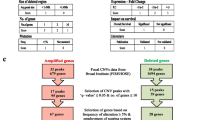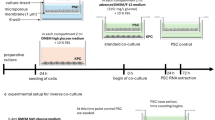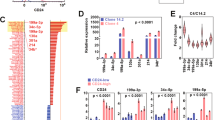Summary
The tumour suppressor gene CDKN2A, located on chromosome 9p21, encodes the cell cycle regulatory protein p16. Inactivation of the CDKN2A gene could lead to uncontrolled cell growth. In order to determine the role of CDKN2A in the development of sporadic ovarian cancer, loss of heterozygosity at 9p21–22, homozygous deletion, mutation and methylation status of the CDKN2A gene as well as CDKN2A expression were examined in a panel of serous papillary ovarian cancer. The frequency of loss of heterozygosity (LOH) for one or more informative markers at 9p21–22 was 65% (15/23). The most common deleted region was located between interferon (IFN)-α and D9S171. Homozygous deletions and mutations of the CDKN2A gene were not found. There was no evidence of methylation in exon 1, but methylation in exon 2 of CDKN2A gene was found in 26% (6/23). Absence of CDKN2A gene expression was shown in 27% (6/22) at mRNA level and 21% (4/19) at protein level. These data suggest that the CDKN2A gene is involved in the tumorigenesis of ovarian cancer, but the mechanisms of CDKN2A gene inactivation in serous papillary ovarian cancer remains unclear.
Similar content being viewed by others
Article PDF
Change history
16 November 2011
This paper was modified 12 months after initial publication to switch to Creative Commons licence terms, as noted at publication
References
An, H. X., Niederacher, D., Beckmann, M. W., Göhring, U. J., Scharl, A., Picard, F., van Roeyen, C., Schnürch, H. G. & Bender, H. G. (1995). ERBB2 gene amplification detected by fluorescent differential polymerase chain reaction in paraffin-embedded breast carcinoma tissues. Int J Cancer 74: 57–63.
Beckmann, M. W., An, H-X, Niederacher, D., Köhrer, K., Finken-Eigen, M., Schröder, W., Schnürch, H. G. & Bender, H. G. (1996a). Oncogene amplification in archival ovarian carcinoma detected by fluorescent differential polymerase chain reaction – a routine analytical approach. Int J Gynecol Cancer 6: 291–297.
Beckmann, M. W., Picard, F., An, H. X., van Roeyen, C. R., Dominik, S. I., Mosny, D. S., Schnürch, H. G., Bender, H. G. & Niederacher, D. (1996b). Clinical impact of detection of loss of heterozygosity of BRCA1 and BRCA2 markers in sporadic breast. Br J Cancer 73: 1220–1226.
Beckmann, M. W., Niederacher, D., Massenkeil, G., Tutschek, B., Beckmann, A., Schenko, G., Schnürch, H. G. & Bender, H. G. (1996c). Expression analyses of epidermal growth factor receptor and HER-2/neu: no advantage of prediction of recurrence or survival in breast cancer patients. Oncology 53: 441–447.
Cairns, P., Mao, L., Merlo, A., Lee, D. J., Schwab, D., Eby, Y., Tokino, K., van der Riet, P., Blaugrund, J. E. & Sidransky, D. (1994). Rates of p16 (MTS1) mutations in primary tumors with 9p loss. Science 265: 415–416.
Campbell, I. G., Foulkes, W. D., Beynon, G., Davis, M. & Englefield, P. (1995). LOH and mutation analysis of CDKN2 in primary human ovarian cancers. Int J Cancer 63: 222–225.
Chenevix-Trench, G., Kerr, J., Friedlander, M., Hurst, T., Sanderson, B., Coglan, M., Ward, B., Leary, J. & Khoo, S. K. (1994). Homozygous deletions on the short arm of chromosome 9 in ovarian adenocarcinoma cell lines and loss of heterozygosity in tumors. Am J Hum Gene 55: 143–149.
Cliby, W., Ritland, S., Hartmann, L., Dodson, M., Halling, K. C., Keeney, G., Podratz, K. C. & Jenkins, R. B. (1993). Human epithelial ovarian cancer allelotype. Cancer Res 53: 2393–2398.
Costello, J. F., Berger, M. S., Huang, H. S. & Cavenee, W. K. (1996). Silencing of p16/CDKN2 expression in human gliomas by methylation and chromatin condensation. Cancer Res 56: 2405–2410.
Del Tito, B. J. Jr, Poff, H. E. 3rd, Novotny, M. A., Cartledge, D. M., Walker, RIII, Earl, C. D. & Bailey, A. L. (1998). Automated fluorescent analysis procedure for enzymatic mutation detection. Clin Chem 44: 731–739.
Devlin, J., Elder, P. A., Gabra, H., Steel, C. M. & Knowles, M. A. (1996). High frequency of chromosome 9 deletion in ovarian cancer: evidence for three tumour-suppressor loci. Br J Cancer 73: 420–423.
Dong, Y., Walsh, M. D., McGuckin, M. A., Gabrielli, B. G., Cummings, M. C., Wright, R. G., Hurst, T., Khoo, S. K. & Parsons, P. G. (1997). Increased expression of cyclin-dependent Chinese inhibitor 2 (CDKN2A) gene product P16INK4A in ovarian cancer is associated with progression and unfavourable prognosis. Int J Cancer (Pred Oncol) 74: 57–63.
Eiriksdottir, G., Sigurdsson, A., Jonasson, J. G., Agnarsson, B. A., Sigurdsson, H., Gudmundsson, J., Bergthorsson, J. T., Barkardottir, R. B., Egilsson, V. & Ingvarsson, S. (1995). Loss of heterozygosity on chromosome 9 in human breast cancer: association with clinical variables and genetic changes at other chromosome regions. Int J Cancer 64: 378–382.
Fujita, M., Enomoto, T., Haba, T., Nakashima, R., Sasaki, M., Yoshino, K., Wada, H., Buzard, G. S., Matsuzaki, N., Wakasa, K. & Murata, Y. (1997). Alteration of p16 and p15 genes in common epithelial ovarian tumors. Int J Cancer 74: 148–1550.
Gray-Bablin, J., Zalvide, J., Fox, M. P., Knickerbocker, C. J., DeCapiro, J. A. & Keyomarsi, K. (1996). Cyclin E, a redudant cyclin in breast cancer. Proc Natl Acad Sci USA 93: 15215–15220.
Gonzalez-Zulueta, M., Bender, C. M., Yang, A. S., Nguyen, T., Beart, R. W., Van Tornout, J. M. & Jones, P. A. (1995). Methylation of the 5′ CpG island of the p16/CDKN2 tumor suppressor gene in normal and transformed human tissues correlates with gene silencing. Cancer Res 55: 4531–4535.
Hatta, Y., Hirama, T., Takeuchi, S., Lee, E., Pham, E., Miller, C. W., Strohmeyer, T., Wilczynski, S. P., Melmed, S., Koeffler HP Kamb, A., Gruis, N. A., Weaver-Feldhaus, J., Liu, Q., Harshman, K., Tavtigian, S. V. & Stockert, E. Day (1995). Alterations of the p16 (MTS1) gene in testicular, ovarian, and endometrial malignancies. J Urol 154: 1954–1957.
RS, 3rd, Johnson, B. E. & Skolnick, M. H. (1994). A cell cycle regulator potentially involved in genesis of many tumor types. Science 264: 436–440.
Kishimoto, Y., Sugio, K., Hung, J. Y., Virmani, A. K., McIntire, D. D., Minna, J. D. & Gazdar, A. F. (1995). Allele-specific loss in chromosome 9p loci in preneoplastic lesions accompanying non-small-cell lung cancers. J Natl Cancer Inst 87: 1224–1229.
Lo, K. W., Cheung, S. T., Leung, S. F., van Hasselt, A., Tsang, Y. S., Mak, K. F., Chung, Y. F., Woo, J. K., Lee, J. C. & Huang, D. P. (1996). Hypermethylation of the p16 gene in nasopharyngeal carcinoma. Cancer Res 56: 2721–2725.
Merlo, A., Herman, J. G., Mao, L., Lee, D. J., Gabrielson, E., Burger, P. C., Baylin, S. B. & Sidransky, D. (1995). 5′ GpG island methylation is associated with transcriptional silencing of the tumor suppressor p16/CDKN2/MTS1 in human cancers. Natl Med 1: 686–692.
Milde-Langosch, K., Ocon, E., Becker, G. & Loning, T. (1998). p16/MTS1 inactivation in ovarian carcinomas: high frequency of reduced protein expression associated with hyper-methylation or mutation in endometrioid and mucinous tumors. Int J Cancer 79: 61–65.
Niederacher, D., Picard, F., van Roeyen, C., An, H. X., Bender, H. G. & Beckmann, M. W. (1997). Patterns of allelic loss on chromosome 17 in sporadic breast carcinomas detected by fluorescent-labeled microsatellite analysis. Genes Chromosomes Cancer 18: 181–192.
Nobori, T., Miura, K., Wu, D. J., Lois, A., Takabayashi, K. & Carson, D. A. (1994). Deletions of the cyclin-dependent kinase-4 inhibitor gene in multiple human cancers. Nature (Lond) 368: 753–756.
Schultz, D. C., Vanderveer, L., Buetow, K. H., Boente, M. P., Ozols, R. F., Hamilton, T. C. & Godwin, A. K. (1995). Characterization of chromosome 9 in human ovarian neoplasia identifies frequent genetic imbalance on 9q and rare alterations involving 9p, including CDKN2. Cancer Res 55: 2150–2157.
Serrano, M., Hannon, G. J. & Beach, D. (1993). A new regulatory motif in cell-cycle control causing specific inhibition of cyclin D/CDK4. Nature 366: 704–707.
Shigemasa, K., Hu, C., West, C. M., Clark, J., Parham, G. P., Parmley, T. H., Korourian, S., Baker, V. V. & O’Brien, T. J. (1997). p16 overexpression: a potential early indicator of transformation in ovarian carcinoma. J Soc Gynecol Investig 4: 95–102.
Shih, Y. C., Kerr, J., Liu, J., Hurst, T., Khoo, S. K., Ward, B., Wainwright, B. & Chenvevix-Trench, G. (1997). Rare mutations and to hypermethylation at the CDKN2A locus in epithelial ovarian tumours. Int J Cancer 70: 508–511.
Spruck, C. H. 3rd, Gonzalez-Zulueta, M., Shibata, A., Simoneau, A. R., Lin, M. F., Gonzales, F., Tsai, Y. C. & Jones, P. A. (1994). p16 gene uncultured tumours. Nature (Lond) 370: 183–184.
Author information
Authors and Affiliations
Rights and permissions
From twelve months after its original publication, this work is licensed under the Creative Commons Attribution-NonCommercial-Share Alike 3.0 Unported License. To view a copy of this license, visit http://creativecommons.org/licenses/by-nc-sa/3.0/
About this article
Cite this article
Niederacher, D., Yan, HY., An, HX. et al. CDKN2A gene inactivation in epithelial sporadic ovarian cancer. Br J Cancer 80, 1920–1926 (1999). https://doi.org/10.1038/sj.bjc.6690621
Received:
Revised:
Accepted:
Published:
Issue date:
DOI: https://doi.org/10.1038/sj.bjc.6690621
Keywords
This article is cited by
-
HSV-2-encoded miRNA-H4 Regulates Cell Cycle Progression and Act-D-induced Apoptosis in HeLa Cells by Targeting CDKL2 and CDKN2A
Virologica Sinica (2019)
-
Meta-analysis demonstrates no association between p16 ink4a promoter methylation and epithelial ovarian cancer
Archives of Gynecology and Obstetrics (2017)
-
Epigenetic alteration of p16 and retinoic acid receptor beta genes in the development of epithelial ovarian carcinoma
Tumor Biology (2014)
-
Chemosensitivity and radiosensitivity profiles of four new human epithelial ovarian cancer cell lines exhibiting genetic alterations in BRCA2, TGF?-RII, KRAS2, TP53 and/or CDNK2A
Cancer Chemotherapy and Pharmacology (2004)



